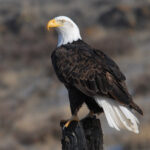Bald eagles (Haliaeetus leucocephalus) are indeed found in the Arctic region, particularly in Alaska, which has the largest population of bald eagles in the United States, estimated at around 30,000 birds. They are often found along Alaska’s coast, offshore islands, and Interior lakes and rivers.
Bald Eagles in Alaska
Most bald eagles in Alaska winter in the southern part of the state, but some leave the state during the cold months. In the Chilkat Valley, over 3,000 bald eagles may congregate in late fall and early winter to feed on spawned-out salmon.
Bald Eagle Diet in the Arctic
Bald eagles are opportunistic feeders, and their diet in the Arctic mainly consists of:
- Fish, such as herring, flounder, pollock, and salmon along the coast
- Waterfowl
- Small mammals
- Sea urchins
- Clams
- Crabs
- Carrion, including the afterbirths, still-borns, and sickly seal pups of gray seals (Halichoerus grypus) and harbor seals (Phoca vitulina)
In Texas, softshell turtles are the most frequently taken prey by bald eagles.
Adaptations to Arctic Conditions
Bald eagles have incredible adaptations that allow them to thrive in harsh Arctic winter conditions. They have thousands of feathers of different types that work in harmony to protect them from cold temperatures, harsh winds, snow, and ice. Their down feathers trap air to be warmed by the body and insulate them from the cold, while their contour feathers have a shaft for structure and strength and overlap like the shingles of a roof, with the exposed ends being waterproof and repelling rain and snow.
Bald eagles fastidiously align, clean, and condition their feathers through preening, which ensures all feathers are in perfect condition to stay warm and healthy. An oil from a special gland above the base of the tail is carefully applied by the eagle to each feather to maintain feather integrity and waterproofing.
Unique Adaptations and Feeding Behaviors
Bald eagles in the Arctic have developed unique adaptations to survive in the harsh winter conditions. They have a diverse diet that includes fish, waterfowl, small mammals, and even carrion, allowing them to thrive in their Arctic habitat.
In Texas, bald eagles have been observed preying on softshell turtles, with many turtles recorded in their diet in the Chesapeake Bay. In Alaska, bald eagles have been known to feed on sea otter pups and even terrestrial mammalian carnivores such as foxes, including Island foxes, Arctic foxes, and grey foxes. These incidents highlight the opportunistic feeding behavior of bald eagles and their ability to adapt to different environments.
Conclusion
In conclusion, bald eagles are indeed present in the Arctic, particularly in Alaska, where they are well-adapted to the harsh winter conditions. They have a diverse diet that includes fish, waterfowl, small mammals, and even carrion, allowing them to thrive in their Arctic habitat. Their incredible feathers provide insulation and waterproofing, enabling them to withstand cold temperatures, harsh winds, snow, and ice.



